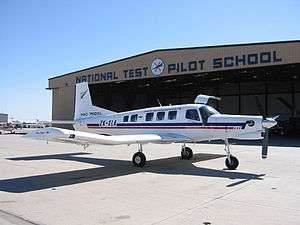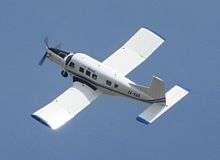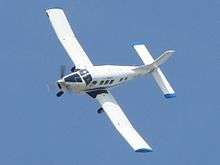PAC P-750 XSTOL
| P-750 XSTOL | |
|---|---|
 | |
| A P-750 XSTOL at the National Test Pilot School in the USA | |
| Role | Utility aircraft |
| National origin | New Zealand |
| Manufacturer | Pacific Aerospace |
| First flight | 2001 |
| Status | Active in production |
| Produced | 2001-present |
| Unit cost |
$US1.7-2.2 million[1] |
| Developed from | PAC Cresco |



The PAC P-750 XSTOL, (formerly known as the PAC 750XL) is a utility aircraft of conventional all-metal low-wing monoplane design, with fixed tricycle undercarriage. Combining the engine and wings of the PAC Cresco with a new large fuselage and modified tail, all versions to date have been powered by a 750 hp (560 kW) Pratt & Whitney Canada PT6 turboprop. It is designed and manufactured in Hamilton, New Zealand by Pacific Aerospace Limited.
Design and development
The design made its maiden flight in 2001. As with the Cresco, horizontal tail surfaces presented difficulties, and these were redesigned before the type entered production. The PAC 750 received full US FAA certification in 2004.
The type was targeted initially to the narrow market of skydiving. In the parachuting role, the high-lift wings from the Cresco and relatively high power-to-weight ratio enable the PAC 750 to take a load of parachutists to 12,000 feet (3,700 m) and return to land in ten minutes.
A wider market was subsequently sought, and examples have been sold for use in utility roles, including freight, agricultural applications, passenger operations, aerial photography and surveying. Two aircraft have been extensively modified for geo-survey work, being fitted with a magnetic anomaly detector sting tail. Proposed ski and float conversions have yet to fly. The P-750 XSTOL is used in South Africa by NatureLink on United Nations Humanitarian Air Services / World Food Programme contracts. While the manufacturer claims lower single-engine running costs than many other utility types, for example, the twin-engined DHC-6 Twin Otter, the type has less usable volume (large cargo panniers providing a partial solution).
In 2008 the manufacturer stated production was increasing from 12 to 24 per year.[2] In 2008 there was some New Zealand media criticism of government assistance for the manufacturer following cancellation of a large order. As of February 2016 a hundred aircraft had been produced.[3]
The aircraft is currently marketed as the P-750 XSTOL. Pacific Aerospace offers the P-750 XSTOL in many configurations - Passenger, Freight/Cargo, Skydive, Agricultural, Aerial Survey and Surveillance. The aircraft is marketed as excelling on rough, unpaved airstrips and is available with a Wide Tyre modification for this purpose. The Defender II version is being developed for counter-insurgency and light attack.
For passenger and cargo operations, the cabin can be outfitted with up to nine passenger seats or with cargo holds. There is also an optional 1,000 lb capacity cargo pod available which attaches to the belly of the aircraft. The aircraft can be configured as all-passenger, all-cargo or a combination of both. All variants have double cargo doors at the rear of the cabin.
In 2012 Pacific Aerospace achieved certification for the P-750 XSTOL against ICAO Annex 6 for Single Engine IFR Commercial Passenger Transport Operations.[4]
A P-750 XSTOL clearly marked with a North Korean flag on its tail was photographed during the Wonsan Air Festival on September 24-25, 2016.[5] It is believed that the Korean People's Army Air Force (KPAAF) is using the type for liaison duties.
Specifications
Data from EASA Type Certificate Data Sheet
General characteristics
- Crew: one (pilot)
- Capacity: Pilot + nine passengers or 17 parachutists [6]
- Length: 11.84 m (38 ft 10 in)
- Wingspan: 12.80 m (42 ft 0 in)
- Height: 4.04 m (13 ft 3 in)
- Wing area: 24.88 m2 (268 ft2)
- Empty weight: 1410 kg (3100 lb)
- Gross weight: 3395 kg (7500 lb)
- Powerplant: 1 × Pratt & Whitney PT6A-34, 560 kW (750 hp) each
Performance
- Maximum speed: 315 km/h (196 mph)
- Cruising speed: 259 km/h (161 mph)
- Stall speed: 107 km/h (66 mph)
- Range: 2183 km (1179 miles)
- Endurance: 8 hours
- Service ceiling: 6098 m (20,000 ft)
See also
- Related development
- Aircraft of comparable role, configuration and era
References
- ↑ "Kiwi aeroplane $120m deal takes off in China". National Business Review. November 12, 2014.
- ↑
- ↑ "100 Up for PAC-750".
- ↑ http://www.aerospace.co.nz/aircraft/p-750xstol/description
- ↑ "How did North Korea get its hands on a New Zealand plane made with American parts?".
- ↑ PAC 750xl page on aerospace.co.nz
External links
| Wikimedia Commons has media related to PAC 750XL. |
- Manufacturers web site
- Page at utilityaircraft.com
- RCAF requirement
- European Aviation Safety Agency Type Certificate Data Sheet
